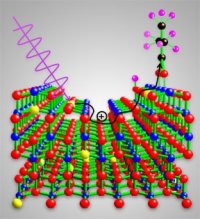Truth Is Stranger Than Science
Article reviews path to discovering true properties of metal oxides
(September 2009)

When transition metal oxide materials like titanium dioxide are combined with small amounts of other elements like nitrogen, the results can be surprising. Enlarge Image
To successfully compete in a global marketplace, manufacturers continually search for better materials: faster drying and less hazardous paint, longer-lasting sunscreen, and faster computers. Transition metal and complex oxide materials exhibit a range of properties unparalleled by any other class of materials. When small amounts of other atoms (called dopants) are inserted into the crystal structure of these materials, the properties of the oxides can change in surprising ways. Understanding how these properties change is critical to using them to improve technologies, and crystalline film growth using dopants is an ideal means of making model oxide materials.
Dr. Scott Chambers, Pacific Northwest National Laboratory Fellow and member of the Institute for Integrated Catalysis, was invited by the editors of Advanced Materials to review the fields of crystalline oxide film growth as well as the electronic, magnetic, optical, and photochemical properties of these important materials.
Not what science expected: Chambers compared various widely used methods for growing transition metal and complex oxide films, focusing on special materials such as titanium dioxide doped with nitrogen, which has recently generated high levels of interest across the scientific community. Nitrogen-doped titanium dioxide absorbs visible sunlight and then releases it as electrical energy to destroy certain organic molecules bound to its surface. This process holds promise for destroying organic waste, but that promise cannot be realized without a more complete understanding of the materials' properties.
Chambers also reviewed another oxide system of current interest among scientists: the junction or interface between strontium titanate and lanthanum aluminate. When prepared by thin film crystal growth methods, the interface conducts electricity, even though strontium titanate and lanthanum aluminate do not. The mechanism of conductivity is controversial.
"We need to understand the true properties of these materials," said Chambers. "Once we clear the fog we can begin to make defensible claims about how new materials will function and how technologies can be developed from them."
The future? At EMSL, a DOE scientific user facility at PNNL, Chambers and his colleagues are actively growing a variety of oxide film materials. They are monitoring and comparing growth parameters such as surface temperature, surface morphology, and film composition and structure for their own experiments, and for those of other scientific organizations in the U.S., Europe, and Asia. Their results will help characterize these promising materials and support materials development efforts around the world.
Acknowledgments: The PNNL work described in this review article was supported by the U.S. Department of Energy's Office of Basic Energy Science and by the National Science Foundation under the Collaborative Research in Chemistry program. The work was performed in EMSL, a DOE national scientific user facility located at PNNL.
Reference: Chambers SA. 2009. "Epitaxial Growth and Properties of Doped Transition Metal and Complex Oxide Films," Advanced Materials, DOI: 10.1002/adma.200901867.
